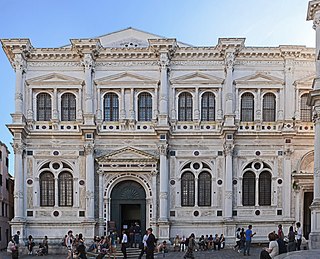
Gentile Bellini was an Italian painter of the school of Venice. He came from Venice's leading family of painters, and at least in the early part of his career was more highly regarded than his younger brother Giovanni Bellini, the reverse of the case today. From 1474 he was the official portrait artist for the Doges of Venice, and as well as his portraits he painted a number of very large subjects with multitudes of figures, especially for the Scuole Grandi of Venice, wealthy confraternities that were very important in Venetian patrician social life.

The Church of Saint Roch is a Roman Catholic church dedicated to Saint Roch in Venice, northern Italy. It was built between 1489 and 1508 by Bartolomeo Bon the Younger, but was substantially altered in 1725. The façade dates from 1765 to 1771, and was designed by Bernardino Maccarucci. The church is one of the Plague-churches built in Venice.

Giovanni di Niccolò Mansueti was an Italian painter.

The Scuola Grande di San Rocco is a building in Venice, northern Italy. It is noted for its collection of paintings by Tintoretto and generally agreed to include some of his finest work.

The Scuola Grande di San Marco is a building in Venice, Italy, designed by the well-known Venetian architects Pietro Lombardo, Mauro Codussi, and Bartolomeo Bon. It was originally the home to one of the Scuole Grandi of Venice, or six major confraternities, but is now the city's hospital. It faces the Campo Santi Giovanni e Paolo, one of the largest squares in the city.

Giuseppe Angeli was an Italian painter of the late-Baroque, known for depicting both genre and religious subjects.

Bartolomeo Bon was an Italian sculptor and architect from Campione d'Italia. His career spans the transition between Venetian Gothic architecture and the rather late start of Venetian Renaissance architecture.
The Scuole Grandi were confraternity or sodality institutions in Venice, Italy. They were founded as early as the 13th century as charitable and religious organizations for the laity. These institutions had a key role in the history and development of music. The first groups of bowed instrument players named Violoni were born there in the early 16th century.

Domenico Robusti, also known as Domenico Tintoretto, was an Italian painter from Venice. He grew up under the tutelage of his father, the renowned painter Jacopo Tintoretto.

The Scuola Grande di San Giovanni Evangelista is a confraternity building located in the San Polo sestiere of the Italian city of Venice. Founded in the 13th century by a group of flagellants it was later to become one of the five Scuole Grandi of Venice. These organisations provided a variety of charitable functions in the city as well as becoming patrons of the arts. The Scuola Grande di San Giovanni Evangelista is notable for housing a relic of the true cross and for the series of paintings it commissioned from a number of famous Venetian artists depicting Miracles of the Holy Cross. No longer in the school, these came into public ownership during the Napoleonic era and are now housed in the Gallerie dell'Accademia. The scuola is open to visitors on a limited number of days, detailed on the official website.

Christ Carrying the Cross is an oil painting attributed to either Titian or Giorgione. It is dated to about 1505. The painting is housed in the Scuola Grande di San Rocco in Venice, Italy. There are several later versions of the subject by Titian.

The Procession in St. Mark's Square is a tempera-on-canvas painting by Italian Renaissance artist Gentile Bellini, dating from c. 1496. It is housed in the Gallerie dell'Accademia in Venice.

The Miracle of the Cross at the Bridge of S. Lorenzo is a tempera-on-canvas painting by Italian Renaissance artist Gentile Bellini, dating from c. 1500. It is now housed in the Gallerie dell'Accademia, in Venice.

The Miracle of the Cross at the Ponte di Rialto, also known as The Healing of the Madman, is a painting by Italian Renaissance artist Vittore Carpaccio, dating from c. 1496. It is now housed at the Gallerie dell'Accademia in Venice.

San Fantin is a church in the sestiere of San Marco in Venice, Italy. It stands in front of the Fenice Theater and adjacent to the Ateneo Veneto.

Venetian Renaissance architecture began rather later than in Florence, not really before the 1480s, and throughout the period mostly relied on architects imported from elsewhere in Italy. The city was very rich during the period, and prone to fires, so there was a large amount of building going on most of the time, and at least the facades of Venetian buildings were often particularly luxuriantly ornamented.

St. Mark Preaching in Alexandria is an oil painting by the Italian Renaissance artists Gentile and Giovanni Bellini, dated to 1504–1507, and held in the Pinacoteca di Brera, in Milan.
Save Venice Inc. is a U.S. non-profit organization dedicated to the conservation of art and architecture and the preservation of cultural heritage sites in Venice, Italy. Headquartered in New York City, it has an office in Venice, a chapter in Boston, and supporters across the United States and Europe.

Massacre of the Innocents is an altarpiece oil painting by Moretto da Brescia, executed in 1531–1532, originally painted on panel but later transferred to canvas. It is on display on a side altar in San Giovanni Evangelista church in Brescia.






















